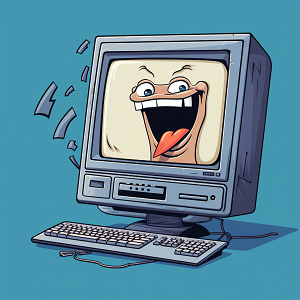
Humor has always been considered a uniquely human trait. The ability to make others laugh, to find amusement in the absurd, is often seen as a testament to our intelligence and creativity. However, as technology advances, it seems that even the realm of comedy is not safe from the influence of machines.
Computer-generated humor, once dismissed as a mere gimmick, has come a long way in recent years. With the development of sophisticated algorithms and machine learning techniques, computers are now able to generate jokes that rival those crafted by humans. In fact, some would argue that machines have even surpassed us in the quest for the funniest jokes.
One of the key advantages of computer-generated humor is its ability to analyze vast amounts of data and identify patterns that humans might miss. By analyzing thousands of jokes and their corresponding reactions from audiences, machines are able to pinpoint the specific elements that make a joke funny. This data-driven approach allows computers to generate jokes that are tailored to specific audiences and have a higher chance of eliciting laughter.
But can machines truly understand humor? While it is true that computers lack the emotional intelligence and context that humans possess, they are able to simulate it to some extent. Natural language processing algorithms enable computers to understand the structure and semantics of jokes, while sentiment analysis allows them to gauge the emotional impact of a punchline. By combining these techniques, machines are able to generate jokes that not only make logical sense but also have a certain comedic timing.
However, the question remains: can computer-generated humor ever truly replace the wit and creativity of human comedians? While machines may be able to generate jokes that are funny on a surface level, they often lack the nuance and subtlety that human comedians bring to their craft. Comedy is not just about making people laugh; it is about challenging societal norms, making insightful observations, and pushing the boundaries of what is considered funny. These are qualities that are difficult to replicate in a machine.
That being said, computer-generated humor does have its place. In addition to providing entertainment, it can also be used as a tool for creativity and inspiration. Comedians and writers can use machine-generated jokes as a starting point, building upon them and adding their own unique perspective. This collaboration between humans and machines has the potential to create a new form of comedy that is both innovative and hilarious.
So, what does the future hold for computer-generated humor? Will machines continue to outwit humans in the quest for the funniest jokes? It is impossible to say for certain. However, one thing is clear: as technology continues to advance, the line between human and machine creativity will become increasingly blurred. And who knows, maybe one day we will find ourselves laughing at jokes that were generated by a computer.
AI-Generated Joke:
Why don’t scientists trust atoms? Because they make up everything!
Human-Crafted Joke:
I told my wife she was drawing her eyebrows too high. She looked surprised.
AI-Generated Joke:
Why did the scarecrow win an award? Because he was outstanding in his field!
Human-Crafted Joke:
Parallel lines have so much in common. It’s a shame they’ll never meet.
AI-Generated Joke:
I asked the librarian if the library had books on paranoia. She whispered, “They’re right behind you.”
Human-Crafted Joke:
Why don’t skeletons fight each other? They don’t have the guts!










